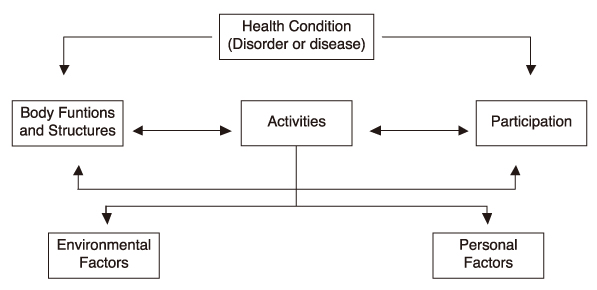J Korean Med Assoc.
2009 Jun;52(6):537-544. 10.5124/jkma.2009.52.6.537.
Changing Concepts and Classifications of Disablement
- Affiliations
-
- 1Department of Physical Medicine & Rehabilitation, Ajou University School of Medicine, Korea. uwrah@hanmail.net
- 2Department of Physical & Rehabilitation Medicine, Inha University College of Medicine, Korea. rmjung@inha.ac.kr
- KMID: 2065047
- DOI: http://doi.org/10.5124/jkma.2009.52.6.537
Abstract
- In spite of a refined classification on the functioning or disability accredited by World Health Organization (WHO, 2001), explicit concepts or definitions of health, disablement and its related terminologies of impairment, disability, handicap, activity limitation and participation restriction are generating considerable confusion in Korea. It is very important to understand the new concepts of these different changing terms in all health related fields. International Statistical Classification of Diseases and Related Health Problems (ICD-10) has reported diagnosis or mortality statistics, but the report did not cover the health status of living populations or information about non-fatal health outcomes. In order to rectify this situation, WHO developed a new tool for the classification of the consequences of disease, namely the International Classification of Impairments, Disabilities and Handicaps (ICIDH) in 1980. Following several revisions, WHO announced the International Classification of Functioning, Disability and Health (ICF) in 2001, which was not based on a medical or a social model, rather on bio-psycho-social and interactive model. WHO recommend the use of the two different classifications to provide relevant and updated information on diagnosis of disease (s) with ICD-10 and also on assessment of functioning or disability with ICF.
Figure
Cited by 1 articles
-
Do age, gender, and subjective health-related factors influence health-related life satisfaction in people with disabilities who are physically active?: a secondary analysis
Hyunseok Cho, Sukhee Ahn
Womens Health Nurs. 2024;30(1):56-66. doi: 10.4069/whn.2024.03.18.
Reference
-
1. Lee KS, editor. Disability evaluation and independent medical examination. 2002. Seoul: Jungang Moonwha Co;15–21.2. Suh TW. Current status and direction of the expansion of statuatory disabilities in the disability act. Independent Med Exam. 2005. 2:12–16.3. Masala C, Petretto DR. From disablement to enablement: conceptual models of disability in the 20th century. Disabil Rehabil. 2008. 30:1233–1244.
Article4. World Health Organization: International classification of imapirments, disabilities and handicaps: A manual of classification relating to the consequences of disease. WHO. 1980. Geneva:5. World Health Organization. International classification of functioning, disabilities and health. WHO. 2001. Geneva:6. Jung HY. Impact and application of the international classification of functioning, disability and health in the medical rehabilitation. J Korean Acad Rehab Med. 2004. 28:401–411.7. Allan CM, Campbell WN, Guptill CA, Stephenson FF, Campbell KE. A conceptual model for interprofessional education: the international classification of functioning, disability and health (ICF). J Interprof Care. 2006. 20:235–245.
Article8. Ustün TB, Chatterji S, Bickenbach J, Kostanjsek N, Schneider M. The international classification of functioning, disability and health: a new tool for understanding disability and health. Disabil Rehabil. 2003. 25:565–571.
Article9. Stucki G, Grimby G. Applying the ICF in medicine. J Rehabil Med. 2004. 44:5–6.10. de Kleijn-de Vrankrijker MW. The long way from the international classification of impairments, disabilities and handicaps (ICIDH) to the international classification of functioning, disability and health (ICF). Disabil Rehabil. 2003. 25:561–564.
Article11. Walsh NE. Global initiatives in Rehabilitation Medicine. Arch Phys Med Rehabil. 2004. 85:1395–1402.
Article12. Geyh S, Cieza A, Schouten J, Dickson H, Frommelt P, Omar Z, Kostanjsek N, Ring H, Stucki G. ICF core sets for stroke. J Rehabil Med. 2004. 44:135–141.
Article
- Full Text Links
- Actions
-
Cited
- CITED
-
- Close
- Share
- Similar articles
-
- Disability Intervention Model for Older Adults with Arthritis: An Integration of Theory of Symptom Management and Disablement Process Model
- Changing Concepts in Treatment of Tuberculosis
- Changing Concepts in the Treatment of Malignant Melanoma
- New Approach in the Treatment of Epilepsy: Efficacy of New Antiepileptic Drugs
- Changing concepts of cancer stem cells and their application into targeted therapy for cancer



